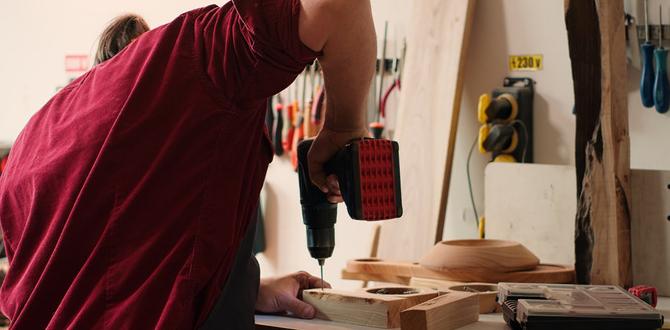To remove old nails from trim effectively, you’ll need a few basic tools like a claw hammer, nail puller, pry bar, and painter’s tape. The key is to protect the trim from damage, leverage gently, and work patiently. This guide will walk you through the simplest and safest methods for a clean removal.
Hey there, fellow DIYers! Jack Shaffer here, your go-to guy for all things nails and woodworking over at Nailerguy. Ever found yourself staring at a piece of beautiful old trim, only to realize it’s riddled with stubborn, rusty nails that are ruining the look or preventing a repair? You’re not alone! Removing old nails from trim can feel like a delicate operation. You want those nails out, but you don’t want to damage that lovely wood in the process. It’s a common challenge in home renovation, especially with older homes. But don’t worry, it’s totally manageable with the right approach and a few handy tools. We’re going to walk through this step-by-step, making sure you can tackle this task with confidence and get great results. Let’s get those old nails out without a fuss!
Table of Contents
Why Removing Old Nails From Trim Matters
There are several good reasons why you might need to remove old nails from trim. Often, it’s about updating the look of a room. Old, visible nails can detract from the aesthetic, especially if you’re repainting or refinishing the trim. They can also snag on things or even cause rust stains over time, compromising the appearance of the wood.
Another common reason is repair or replacement. If the trim is damaged and needs to be removed for a more extensive repair or replaced entirely, those nails are in the way. Trying to force damaged trim off without removing nails can lead to even more breakage, making the job harder and more expensive.
Sometimes, you might be salvaging wood from an old project or a demolition. Old nails are obstacles to reusing that beautiful timber. Safely removing them ensures the wood remains in good condition for its next life, whether that’s in a new piece of furniture, a decorative accent, or another architectural feature.
Finally, safety is a big factor. Protruding or loose nails can be a hazard, especially in homes with children or pets. Removing them makes the space safer and tidier. Whatever your reason, taking the time to remove nails correctly will make your project much smoother and yield a far better result.
Tools You’ll Need
Gathering the right tools before you start will make the job much easier and significantly reduce the risk of damaging your trim. Here’s what I recommend having on hand:
- Claw Hammer: A standard hammer with a V-shaped claw is essential. This is your primary tool for many nail removal tasks.
- Pry Bar (or Cat’s Paw Nail Puller): A small pry bar, sometimes called a flat bar, or a specialized cat’s paw nail puller is excellent for getting under nail heads and providing leverage without excessive force. The cat’s paw has a sharper, more pointed claw designed specifically for digging into wood to grab nail heads.
- Pliers (Needle-Nose or Locking): Useful for gripping nails that are too short or too damaged to get a good grip with a hammer or pry bar. Locking pliers (like Vise-Grips) can offer a very secure hold.
- Putty Knife or Thin Scraper: This is crucial for protecting the trim’s surface when using leverage tools. It acts as a buffer between your tool and the wood.
- Painter’s Tape: Applying painter’s tape around the nail head can provide an extra layer of protection for the trim’s finish.
- Safety Glasses: Always protect your eyes! Small metal fragments can fly off nails or trim as you work.
- Gloves: Especially if dealing with rusty nails, gloves will protect your hands from splinters and rust.
- Wood Block or Dowel (Optional): Can be used as a fulcrum to increase leverage and protect the trim surface if you’re using a larger pry bar.
Having these tools ready means you won’t have to stop and search for something mid-project. It’s all about being prepared!
Methods for Removing Nails from Trim
There are a few effective methods, and the best one often depends on the nail type, how deeply it’s embedded, and the condition of the surrounding trim. Let’s break them down:
Method 1: The Classic Claw Hammer Technique
This is the most straightforward method and works well for nails that aren’t too stubborn or where the head is accessible.
- Protect the Trim: Slide a putty knife or a thin piece of scrap wood under the hammer’s claw, right where it will rest against the trim. This prevents the hammer head from marking or denting the wood.
- Position the Claw: Carefully slide the claw of the hammer under the head of the nail. Try to get as much of the claw underneath the nail head as possible. If the nail head is damaged, you might need to gently tap the claw under it with another hammer or a block of wood.
- Apply Gentle Leverage: Gently rock the hammer backward. As you lift, the nail should start to pull out of the wood. If the nail is tight, try wiggling the hammer slightly from side to side while applying upward pressure.
- Continue Pulling: Once the nail is raised enough, you can often switch to pulling the hammer straight back, or reposition the claw for better leverage. Some hammers have a second, more pointed claw that’s useful for ripping nails out.
- Dealing with Resistance: If the nail doesn’t move, don’t force it too hard. You might need to try a different tool or method. For nails that are flush or slightly below the surface, you might need to use the pointed claw of the hammer or a nail puller to get underneath.
This method is fantastic for nails where the head is proud of the surface and isn’t clenched too tightly. Remember, patience is key – you don’t want to gouge the wood!
Method 2: Using a Pry Bar or Cat’s Paw
When nails are stubborn, damaged, or set deeper, a pry bar or cat’s paw is your best friend. A cat’s paw nail puller is particularly effective because its sharpened, beveled claws are designed to dig into the wood just enough to get a grip under a nail head, even if it’s slightly recessed.
- Protect the Surface: Just like with the hammer, place a thin piece of wood, a putty knife, or even a folded piece of sturdy cardboard between the pry bar’s flat end and the trim. This is non-negotiable for protecting your finish!
- Position for Leverage: With the cat’s paw, you might need to tap the claw end gently into the wood right next to the nail head to create a purchase point. For a pry bar, slide the flat end under the nail head, ensuring your protective material is layered underneath.
- Leverage Carefully: Apply steady, upward pressure. Work the pry bar or cat’s paw back and forth gently. The goal is to create upward tension, slowly easing the nail out.
- Use a Fulcrum (If Needed): If you need more leverage, place a small block of wood or a sturdy dowel under the pry bar, near the trim. This acts as a fulcrum, increasing your leverage and distributing the force further away from where the bar meets the wood. This dramatically reduces the pressure on any single spot of the trim. Always ensure your protective padding is still in place between the pry bar and the trim.
- Multiple Passes: For really stubborn nails, you might need to make several small pulls rather than one big heave. Gently lift a bit, reposition if necessary, and lift again.
This method offers superior leverage and is often the choice for professionals when a standard hammer isn’t cutting it. Read more about different types of nail pullers and how they work from fine woodworking.
Method 3: Pliers for Stubborn or Damaged Nails
Sometimes, nail heads break off, or nails are too short to get a good grip with a hammer or pry bar. That’s where pliers come in handy.
- Grip the Nail: Use sturdy pliers, like needle-nose or locking pliers, to get a firm grip on the exposed part of the nail shank. If using locking plier, clamp them down tightly.
- Pull Straight Out: Once you have a good grip, pull the nail straight out of the wood. Wiggling slightly can sometimes help.
- If the Nail is Flush: If the nail is almost flush with the surface, you can try to use the tip of a sharp utility knife to carefully score around the nail head, creating a small opening to get a better grip with the pliers. Alternatively, gently tap the pliers onto the nail head to partially embed them, then pull.
- When Heads are Gone: If the nail head is completely gone and the shank is buried, you might need to carefully excavate a tiny bit of wood around the shank with a utility knife or a fine-point awl to expose enough to grip. This requires a delicate touch to avoid damaging the trim.
Locking pliers (Vise-Grips) are particularly effective here because once clamped, they maintain a strong grip, allowing you to use both hands to pull. This is a great backup when other methods fail.
Method 4: The “Push Through and Pull” for Hidden Nails
Sometimes, nails are driven in and not fully removed, or they’re set just below the surface, making them impossible to grip. In these cases, you might need to gently drive them further into a cavity or through to the other side if possible.
- Locate the Nail: Use a nail set or a punch with a hammer to gently tap the nail head further into the wood. Aim to drive it just enough so it clears the trim’s surface or sinks into a void behind it, if one exists. For trim that might have a hollow cavity behind it, you might be able to drive the nail completely THROUGH the trim and into the wall cavity.
- Assess the Situation: If the nail goes through to the other side, you can then access it from the back (if possible) and pull it out with pliers or a hammer. If it’s driven into a void within the trim itself, you’ve essentially made it less of a protruding hazard.
- Alternative: Prying from Stud: If you’re removing the entire trim piece and it’s attached to a stud, you might be able to get leverage from the wall side. Carefully place your pry bar or hammer claw against the stud and pry the trim (and the nail) away from the stud. This is a more aggressive method and requires care to avoid damaging the wall surface.
This method is usually a last resort or useful when replacing the trim entirely and aiming to minimize damage to the wall. It’s about strategically managing the nail’s position.
Tips for Protecting Your Trim
This is arguably the most crucial part of removing nails from trim. Nobody wants to spend hours repairing damage caused by the removal process itself! Here are some tried-and-true tips:
- The Power of Painter’s Tape: Before you even think about inserting a tool, apply a layer or two of good quality painter’s tape around the nail head. This creates a sacrificial barrier that can absorb minor scratches or dents.
- Use Cardboard or Wood Shims: Always, always, always place a buffer layer between your tool (hammer claw, pry bar) and the trim. A small piece of thin cardboard, a wood shim, a plastic putty knife, or even a scrap of thin plywood works wonders. This spreads the pressure and prevents the tool from digging into the wood.
- Gentle and Steady Pressure: Avoid jerky movements or excessive force. Steady, controlled pressure is much more effective and less likely to damage the trim. Think of it as coaxing the nail out, not wrestling it.
- Work in Stages: If a nail is very tight, don’t try to pull it out in one go. Lift it a tiny bit, then readjust your tool or approach for the next lift. Small, repeated efforts are better than one big, potentially damaging heave.
- Wiggle Wisely: A slight side-to-side wiggle while applying upward pressure can help loosen a stubborn nail. However, do this gently to avoid cracking the wood.
- Consider the Nail Type: Different nails behave differently. Old square-cut nails might be brittle, while modern ring-shank nails are designed to hold tight. Be aware of what you’re dealing with.
- Clean Up Debris: As you work, clear away any loose wood fibers or debris that might accumulate around the nail. This ensures you have a clear view and a better grip.
- Don’t Be Afraid to Stop: If a nail is proving extremely difficult and you feel you’re about to damage the trim, reassess. You might need to try a different tool, a different angle, or perhaps even accept that a small amount of repair will be needed afterward.
Following these protective measures will make a huge difference in the final appearance of your trim. It’s the hallmark of careful workmanship!
Dealing with Different Types of Trim
The type of trim you’re working with can influence how you approach nail removal. Each material has its own characteristics and vulnerabilities:
Wood Trim
This is the most common and generally forgiving. However, softwoods like pine or fir can dent and scratch easily, while hardwoods like oak are more durable but can still be damaged if you’re not careful. Always start with protective measures and gentle force. For painted wood trim, the paint layer can sometimes help hold the surface together, but it can also chip away if you’re not careful.
MDF Trim
Medium-Density Fiberboard (MDF) trim is common in newer homes. It’s less forgiving than wood. It can disintegrate if too much force is applied or if it gets excessively wet. Nails in MDF can be particularly difficult because the material can crumble around them. Use a very fine-tipped tool for leverage and focus on a smooth, direct pull. Protect the surface rigorously. Often, if nails are very stubborn in MDF, it might be easier to accept some surface damage and plan for filler and repainting.
Plaster and Lath Walls (Older Homes)
If your trim is old and installed on lath and plaster walls, be aware that the plaster can be brittle. When you pull nails, especially if they run through the trim and into the lath, the plaster around the nail hole can chip or crack. It’s often best to remove the trim slowly and very carefully. A thin pry bar used with extensive padding is recommended. For nails going into the lath, you might find they are easier to pull once you have some leverage against the stud.
Removing Nails from Casing and Baseboards
Casing (around doors and windows): This is often delicate work. There’s usually not much room to maneuver, and the profile of casing can make it hard to get good tool contact without slipping. Painter’s tape is your best friend here. A thin pry bar or a cat’s paw used very carefully is usually the way to go. Take your time, and protect every contact point.
Baseboards: These are typically thicker and might provide a bit more surface area to work with. However, they’re also more prone to getting kicked or bumped, so their finish can be damaged easily. If the baseboard is to be replaced, you might be able to pry it away from the wall, using the wall itself as a backing for your pry bar (with padding, of course!). If you’re keeping the baseboard, the same careful methods apply as for any other trim.
Removing Rusted or Burnt-in Nails
Old houses often have nails that have rusted, which can make them brittle, or in some cases, they can become “burnt in” to the wood from old finishes or adhesives. Here’s how to approach these trickier situations:
Rusted Nails
Rusted nails can be a double-edged sword. The rust might have weakened the nail, making it easier to break, but it can also expand the wood fibers, making the nail harder to extract.
- Soften the Rust: Sometimes, a little penetrating oil (like WD-40 or PB Blaster) applied to the nail head and allowed to soak for a while can help loosen rust and make extraction easier. Clean up any excess oil from the wood surface afterward.
- Gentle Extraction: Because rusted nails can be brittle, apply steady, even pressure rather than sharp jerks. A sudden yank could snap the nail shank, leaving a piece embedded in the wood, which is much harder to deal with.
- Protect the Wood: Always use your protective padding. Rusted nails can sometimes have sharp edges or fragments that can easily gouge the wood.
“Burnt-In” Nails
Nails that seem fused to the wood, often from layers of paint, varnish, or even heat during older woodworking processes, can be the most challenging. They might not have a visible head or the head might be completely sealed by finish.
- Scrape Away the Finish: Carefully use a sharp utility knife or a razor blade to scrape away any paint or finish surrounding the nail head. You need to see the actual nail head to get a good grip



